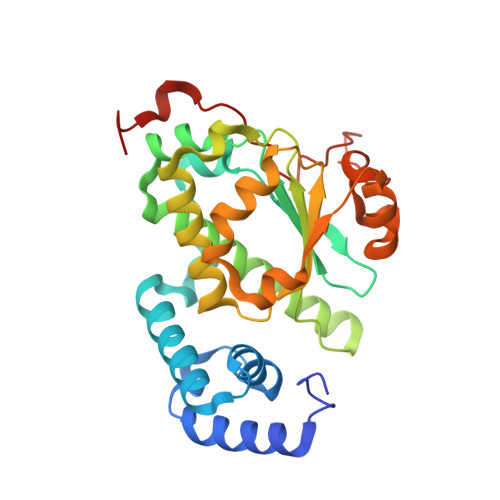Structural insights on cholesterol endosynthesis: Binding of squalene and 2,3-oxidosqualene to supernatant protein factor.
Christen, M., Marcaida, M.J., Lamprakis, C., Aeschimann, W., Vaithilingam, J., Schneider, P., Hilbert, M., Schneider, G., Cascella, M., Stocker, A.(2015) J Struct Biol 190: 261-270
- PubMed: 25987292
- DOI: https://doi.org/10.1016/j.jsb.2015.05.001
- Primary Citation of Related Structures:
4OMJ, 4OMK - PubMed Abstract:
We present the crystal structures of the SEC14-like domain of supernatant protein factor (SPF) in complex with squalene and 2,3-oxidosqualene. The structures were resolved at 1.75Å (complex with squalene) and 1.6Å resolution (complex with 2,3-oxidosqualene), leading in both cases to clear images of the protein/substrate interactions. Ligand binding is facilitated by removal of the Golgi-dynamics (GOLD) C-terminal domain of SPF, which, as shown in previous structures of the apo-protein, blocked the opening of the binding pocket to the exterior. Both substrates bind into a large hydrophobic cavity, typical of such lipid-transporter family. Our structures report no specific recognition mode for the epoxide group. In fact, for both molecules, ligand affinity is dominated by hydrophobic interactions, and independent investigations by computational models or differential scanning micro-calorimetry reveal similar binding affinities for both ligands. Our findings elucidate the molecular bases of the role of SPF in sterol endo-synthesis, supporting the original hypothesis that SPF is a facilitator of substrate flow within the sterol synthetic pathway. Moreover, our results suggest that the GOLD domain acts as a regulator, as its conformational displacement must occur to favor ligand binding and release during the different synthetic steps.
- Department of Chemistry and Biochemistry, University of Bern, Freiestrasse 3, CH-3012 Bern, Switzerland.
Organizational Affiliation:



















